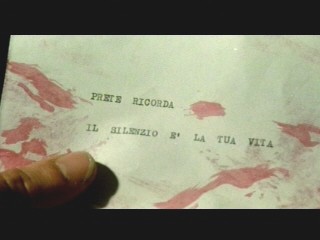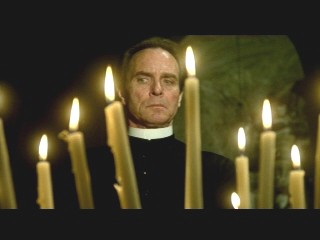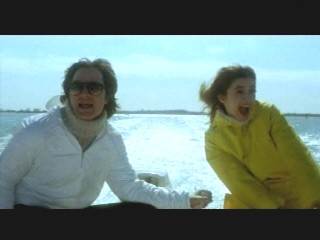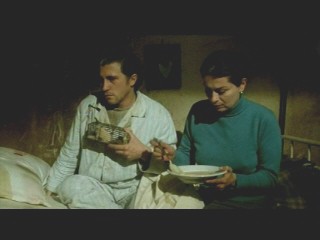
|
|
|
|
|
|
|
|
|
|
|
|
|
(a.k.a. Solamente Nero) (1978) Director: Antonio Bido
After all these years of preaching about the wonders of Italian cinema, from spaghetti westerns to the comic genius of Terence Hill/Bud Spencer movies, I was surprised to realize the other day that not once had I ever reviewed a giallo movie. First, an explanation of the genre and its origin for readers who are unfamiliar with it. "Giallo", of course, is the Italian word for "yellow". The color was first associated with horror in Italy in the 1930s, when a publishing firm in the country started to crank out a line of cheap mass-market paperbacks containing lurid stories that generally involved crime or horror. The paperbacks had yellow backdrops (hence the term) splashed behind horrific pictures of events supposedly in these novels. I can understand that kind of crass promotion on the publisher's part, since front covers can hit you emotionally and be hard to forget; in my case, I am seriously creeped out by the covers of the albums Daryl Hall & John Oates and Neil Diamond's Hot August Night. Anyway, with these paperback popular for the next few decades, the elements of violence and atmosphere from the most popular authors like Edgar Wallace were seeds of sorts in the minds of Italian filmmakers. Though the genre showed signs of emergence back in the early '60s in films like Mario Bava's Black Sunday, it was not until around the turn of the decade, with movies like The Bird With The Crystal Plumage and Twitch Of The Death Nerve, that giallo had become what it's commonly thought of today. Of course, just because a horror film - then or now -
happens to be an Italian production, it doesn't automatically make it
giallo. After you watch several legitimate examples of the genre, you
will have started to make a list of a number of reoccurring elements to
be found in these films. It's unlikely you will see them all in
any particular example, and there are indeed a few examples that have
next to none... but it's almost certain that you will check off a good
number of these elements on your mental list while watching a giallo.
For example, many of these movies start off with the central character
arriving or newly arrived to a While this is happening, it's very likely the central character knowingly (or not) is being stalked by the killer. The killer is usually dressed up in heavy clothing and gloves (black, inevitably) that disguise him or her while either running away from being identified or while continuing to stack up a body count. The killer's weapon of choice is usually a sharp instrument, knives but also stuff like scissors. The rest of the time it's strangling or smothering (you never see giallo killers using baseball bats or shotguns as their modus de operandi.) So with all this mayhem going on, all the characters will understandably be on edge, though at least one will probably still have a willingness at one point to walk (alone) down the quiet and dark cobblestone streets in the older part of some Italian city. (Watch out for those shadows!) - or be home alone. When the killer is finally identified, it's almost inevitable that his or her motivation comes from a traumatic incident in the past, and it's almost inevitable we'll be shown a flashback to that incident. While I'll never say most gialli follow this exact formula - many have radically different plots - I will repeat that it's likely each will have at least a few of those characteristics listed above, and/or other characteristics of the genre I don't have the space to list. In the case of The Bloodstained Shadow, however, we have a giallo that sticks pretty closely to the above formula. Having watched a number of these kind of movies in the past, often with outlandish titles like What Are Those Strange Drops Of Blood Doing On Jennifer's Body? slapped on them, I already had something of an idea of how this was going to play out after just a few minutes in the movie. Despite this, I still enjoyed the movie for several reasons. One reason was that even though the movie had a number of predictable elements, in this particular case they were well done for what they were. Another reason being that there are some genuine unexpected things that happen along the way, things that add to the genuine feeling of mystery that builds and really keeps you guessing until the end of the movie. The first few minutes of the movie follow the standard routine, including having the movie open with a brutal murder by some unknown assailant. Then we are introduced to burned-out university professor Stefano (Capolicchio, The House With Laughing Windows), who leaves Rome for some R&R, deciding to go back to his hometown on an island near Venice and stay with his Catholic priest brother Paolo (Hill, Anguish). During the journey, Stefano comes across Sandra (Casini,
Suspiria), who's both an Those are not the only figures suspected of the murder. Not only that, with each suspect there seems to be at least one possible motivation for the murder. What's remarkable is that with all these characters, motivations, and assorted secrets and mysterious occurrences that come into play, The Bloodstained Shadow manages to stay remarkably coherent. A common problem to be found in the genre is that the movies try to put in so much information, so quickly, that often you get confused as to who is who and what facts are known at any moment. In this instance, the events unfold at a much slower pace, and everything that we need to know is spoon-fed to us one bite at a time. For example, after Sandra and Stefano arrive at the island, she goes her own way, not to reappear until later. Though we don't know much about her at this point, we don't need to know more about her at this time. Knowing little about her at this point, as a matter of fact, makes it easy to file her away in our memory for future reference. Now without her around, the movie can concentrate fully on the next scene (Stefano and Paolo meeting), and give us a few more pieces of information, no more than we need to know for the time. Each subsequent scene works more or less the same way - giving us a little new information or changing the situation slightly. With such gradual new information, and the gradual changes to this information, it's pretty simple to keep track of everything and everyone. While the leisurely pace keeps everything in the movie
at an understandable level, it does backfire to a small degree. The
less frantic pace As it so happens, a supplement on the DVD for the movie contains an interview with director Bido, who does more or less admit he made a mistake with putting this material in the movie. There are a few other lapses in judgment in the movie that I suspect he also regrets. The homosexual-tinged behavior of the piano teacher and his live-in "assistant" is really overdone, and seems to be a bad effort at comic relief. Some other parts of the movie do induce laughs, but they are of an unintentional nature, specifically the melodrama surrounding the strange flashbacks Stefano keeps having, and the blasé attitude he and Sandra have after someone close to them falls victim to the murder. Also, I wish that the mystery had been solved without the use of coincidence, namely with one of the characters just happening to see a certain painting that indirectly gives them a clue, and with the same thing also happening when the character happens to be at the right place and time to see an envelope. When you use coincidence like this, it comes across as cheating, as if the characters in the movie can't solve the mystery on their own without some extra help from the screenwriters. Despite these problems, I really enjoyed The
Bloodstained Shadow. While it's seldom mentioned in discussions
of the genre, or even appear on many fans' "best" lists, it's one of my
favorites. And not just because its mystery always makes sense, The elements of horror in the movie aren't so "natural", of course, but they come across in a subtle manner, quite a lot more than other gialli. The score (by Tentacles' Stelvio Cipriani, though performed by Goblin) may strike you at first as not being very elaborate, but that's what makes it creepy. It's often simple repetition of familiar sounds - tappings, pieces of wood struck together, or what sounds like a helicopter in slow motion. It turns out to be more unnerving than an elaborate orchestral movement that tries to force fear into you. The lighting also doesn't try forcing fear by dimly lighting everything. Every moment of horror in the movie is clearly visible, though at the same time around the edges you see pitch-black shadows somehow striking their way into these well-lit rooms; the paradox is unnatural, and puts you on edge because it doesn't feel quite right. There was also a lot of though placed in the actual killings as well. Usually in these movies, or in straight slashers, you can guess almost the exact time when the knife is plunged. This time around, however, the "plunges" always come when you least expect it, right out of the blue. While watching The Bloodstained Shadow, you sense Bido was trying to be different, to try and give his audience surprises. In fact, he goes to the trouble in one scene to brilliantly parody the tired clichéd standard stalk-and-slash, right down to the musical "sting" these scenes have. I'm surprised it took so long for someone to do that. Check for availability on Amazon (DVD) See also: Crawlspace, Shadow Dancing, Terror House |
 place not
familiar to him, or a place that this character hasn't been to in
years. If not, it's still likely he or she in the beginning will be in
a situation making them feel to a degree alienated from everything and
everyone around him or her. Shortly after this setup (or sometimes
right before it), there's usually a violent murder committed by some
unidentified individual. Chances are good that the main character will
witnesses or stumble across the murder scene after the fact if it
occurs after his introduction. The central character may not be able to
reach the police, but if he or she does, the police at the time will
turn out to be pretty clueless, and may even suspect the central
character of being behind the crime. Possibly one cop investigating the
crime will piece things together... eventually, just in time to arrive
and stop our character getting killed by the culprit in the climax.
Going back to just after the initial murder, the main character will
probably start a personal investigation of sorts, encountering many
eccentric characters and suspects along the way. Likely these
characters will have one extreme attribute each - vanity, body weight,
wealth, insanity, etc.
place not
familiar to him, or a place that this character hasn't been to in
years. If not, it's still likely he or she in the beginning will be in
a situation making them feel to a degree alienated from everything and
everyone around him or her. Shortly after this setup (or sometimes
right before it), there's usually a violent murder committed by some
unidentified individual. Chances are good that the main character will
witnesses or stumble across the murder scene after the fact if it
occurs after his introduction. The central character may not be able to
reach the police, but if he or she does, the police at the time will
turn out to be pretty clueless, and may even suspect the central
character of being behind the crime. Possibly one cop investigating the
crime will piece things together... eventually, just in time to arrive
and stop our character getting killed by the culprit in the climax.
Going back to just after the initial murder, the main character will
probably start a personal investigation of sorts, encountering many
eccentric characters and suspects along the way. Likely these
characters will have one extreme attribute each - vanity, body weight,
wealth, insanity, etc. art student headed
for the island and the eventual love interest and confidant for the
hero that you often find in these kind of movies. They go their
separate ways upon reaching the island, and Stefano and Paolo have a
warm reunion. That night, right outside the church, there is a murder -
which is witnessed by someone inside the church. In a surprise twist,
it's not Stefano who witnesses the crime, but Paolo. Though
you'll probably not be so surprised to subsequently learn that both
Stefano and Paolo's assistant just happened to be outside of the
building at the time of the murder. Nor that the victim, a medium, is
connected to several creepy townspeople who came to her séances. They
are all suspects as well; there's the town doctor who accidentally(?)
killed his wife while cleaning his gun several years back, the midwife
(who works part-time as an abortionist to even things out) that rumor
claims is secretly hiding a deranged son from the authorities, and
there is the town pedophile whose noble background keeps him from being
prosecuted (though strangely, the parents still send their kids to him
for piano lessons), all of who have those famously complicated-sounding
Italian names that I know I'll get wrong if I try to write them out, so
I won't even try.
art student headed
for the island and the eventual love interest and confidant for the
hero that you often find in these kind of movies. They go their
separate ways upon reaching the island, and Stefano and Paolo have a
warm reunion. That night, right outside the church, there is a murder -
which is witnessed by someone inside the church. In a surprise twist,
it's not Stefano who witnesses the crime, but Paolo. Though
you'll probably not be so surprised to subsequently learn that both
Stefano and Paolo's assistant just happened to be outside of the
building at the time of the murder. Nor that the victim, a medium, is
connected to several creepy townspeople who came to her séances. They
are all suspects as well; there's the town doctor who accidentally(?)
killed his wife while cleaning his gun several years back, the midwife
(who works part-time as an abortionist to even things out) that rumor
claims is secretly hiding a deranged son from the authorities, and
there is the town pedophile whose noble background keeps him from being
prosecuted (though strangely, the parents still send their kids to him
for piano lessons), all of who have those famously complicated-sounding
Italian names that I know I'll get wrong if I try to write them out, so
I won't even try. often threatens to
bring the movie to a standstill, which it ultimately does for several
minutes at one point of the movie. That's when Stefano and Sandra take
a break from all the horrible things that have happened, and spend the
day in a long montage of them happily motoring off the coast of Venice.
This hurts the movie in more than one way. Not only is this sequence a
complete waste of time, but the carefree and joyful mood they
experience breaks the sombre and effective mood that has been lurking
around all of this time. It gets worse when instead of jumping back to
the story, this intermission of sorts is extended with the next
immediate thing being a sex scene between the two. This particular
scene also seems out of place when you consider that up to this point
in the movie, Stefano and Sandra's relationship was still at that early
stage when both individuals are still struggling to get rid of the
remaining beginning awkwardness that prevents them from being fully simpatico.
After these two back-to-back sequences, it takes a while for the movie
to fully recover.
often threatens to
bring the movie to a standstill, which it ultimately does for several
minutes at one point of the movie. That's when Stefano and Sandra take
a break from all the horrible things that have happened, and spend the
day in a long montage of them happily motoring off the coast of Venice.
This hurts the movie in more than one way. Not only is this sequence a
complete waste of time, but the carefree and joyful mood they
experience breaks the sombre and effective mood that has been lurking
around all of this time. It gets worse when instead of jumping back to
the story, this intermission of sorts is extended with the next
immediate thing being a sex scene between the two. This particular
scene also seems out of place when you consider that up to this point
in the movie, Stefano and Sandra's relationship was still at that early
stage when both individuals are still struggling to get rid of the
remaining beginning awkwardness that prevents them from being fully simpatico.
After these two back-to-back sequences, it takes a while for the movie
to fully recover.  even when things
seriously start to twist and turn just before the end. The entire cast
is dubbed (I recognized the voice of the guy who usually dubs Bud
Spencer), but the dubbing for this movie is pretty well done, with
well-chosen voice actors managing to get quite close to the lip
movements. We might not hear the voices of the onscreen actors, but
they express themselves well visually; you also don't get from them the
pretentious feeling you often get from glossy Hollywood stars. This is
a bare-bones low-budget movie, though it never looks cheap. Almost
every scene is shot on location, indoors or outdoors, so it looks and
feels more "real" than even the fanciest constructed sets. Traveling
with the characters down the streets and in and out of the buildings,
you really do feel the atmosphere of a small and isolated Italian
village that's been around for centuries. There's some nice local color
added with extras placed in the background, from villagers casually
chatting and laughing in a restaurant, to black-clothed old ladies
silently walking past in nearly-empty streets.
even when things
seriously start to twist and turn just before the end. The entire cast
is dubbed (I recognized the voice of the guy who usually dubs Bud
Spencer), but the dubbing for this movie is pretty well done, with
well-chosen voice actors managing to get quite close to the lip
movements. We might not hear the voices of the onscreen actors, but
they express themselves well visually; you also don't get from them the
pretentious feeling you often get from glossy Hollywood stars. This is
a bare-bones low-budget movie, though it never looks cheap. Almost
every scene is shot on location, indoors or outdoors, so it looks and
feels more "real" than even the fanciest constructed sets. Traveling
with the characters down the streets and in and out of the buildings,
you really do feel the atmosphere of a small and isolated Italian
village that's been around for centuries. There's some nice local color
added with extras placed in the background, from villagers casually
chatting and laughing in a restaurant, to black-clothed old ladies
silently walking past in nearly-empty streets.